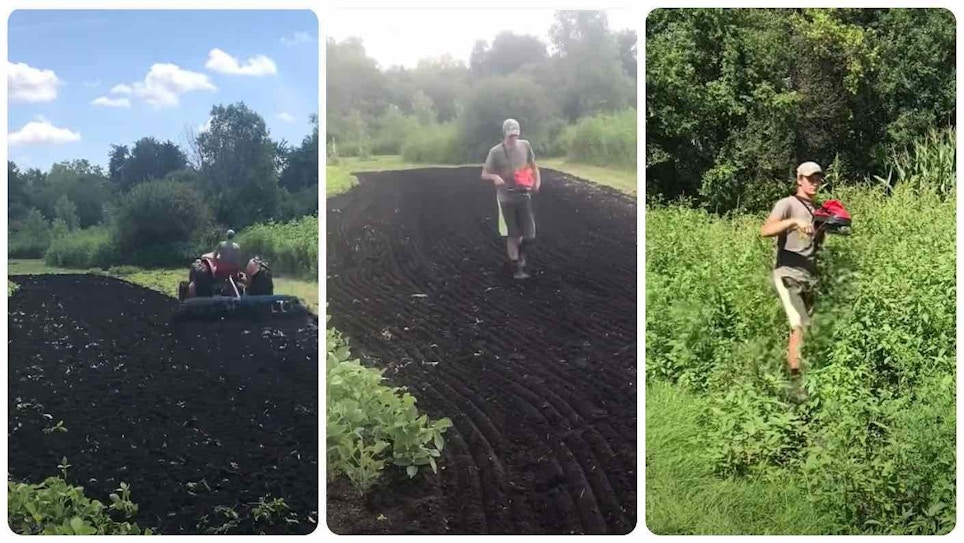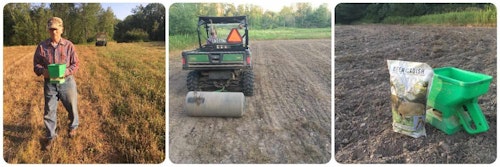
Is it better to work the soil with a disk and then plant brassicas (left and center photos), or broadcast seed over a weedy field (right) and then flatten the weeds and spray to kill them? The video at the bottom of the page answers this question.
In my opinion, this 18-minute YouTube video from Wisconsin Whitetail is tremendously interesting and helpful. Each spring and fall, I debate (kind word for “argue”) with my father about food plots on our whitetail property in Wisconsin. Dad owns an ATV as well as a compact tractor with all the implements: rotary tiller, two disks, cultipacker, drag and sprayer.

Our disagreements center around the pros and cons of disking prior to planting. Dad loves to “work the soil.” When you watch the video below, Dad likes his food plots to look exactly like what you see at the 2:57 mark. He wants to broadcast seed on a perfect blanket of black dirt. As explained in the video, we often roll the field with a cultipacker after disking (or tilling) to ensure that tiny brassica seeds aren’t buried too deep in the fluffy soil, then we roll the field again after spreading seed. This process works great to guarantee seed-to-soil contact. Note: This disked field and neighboring no-till field are both planted on August 7. The soil quality is the same (both are very good).
In contrast to this very clean disking method, check out the 7:00 mark of the video when the host begins planting his no-till food plot. Many of the growing green weeds are more than 4 feet tall, and it’s thick. Unless you bend down to look at the ground, you can’t even see the soil through the weeds. After broadcasting seed, he flattens the weeds with a cultipacker and ATV, then he sprays the food plot with glyphosate (the active ingredient in Roundup). Important note: Glyphosate doesn’t harm the seed.
At the 8:52 mark, the host shows both fields only 4 days after planting. The area was blessed with rain, and you can see new brassica and soybean plants beginning to grow. But which field will ultimately produce the best result?
Spoiler alert: At the 10:26 mark, the host shows both fields 23 days after planting. Remember the clean blanket-of-black-soil food plot? Yeah, it’s green alright, but it’s been overrun with weeds. And to my knowledge, there’s nothing you can spray on his food plot now that will kill weeds but not harm brassicas. As the host explains, he hopes the weeds will die after the first frost, which will clean up the field.
That’s the problem with disking or tilling and then planting immediately afterward: You bring weed seeds from deeper in the soil to the surface, and with a bit of rain and some sun, those seeds germinate and you will grow a field of thick weeds.
Contrast the disked field with the one where the host never disturbed the soil. In the no-till field, all the weeds which were flattened and then sprayed with glyphosate are dead, and there’s only a few new weeds that have started to grow. The brassicas (and soybeans) will flourish in this field because of no competition. In addition, the decomposing weeds in this field will continue to provide nutrients to the soil.
The host visits the two fields a final time 40 days after planting (September 16) at the 13:48 mark. He actually refers to the disked field as the “weedy plot.” Yes, the brassicas are growing okay, and deer will feed on them, but weeds are still dominating the food plot. In contrast, the no-till field is relatively clean (free of actively growing weeds), and the brassicas look good. He explains that the difference in brassica height from one field to the other is likely due to different timing with fertilizer.
I plan to show my dad this video in hopes to convince him to stop disking or tilling prior to planting our food plots. The takeaway is you don’t need to own a compact tractor and a disk (or rotary tiller) to have decent food plots. In fact, you can do an ever better job, and still plant good-sized food plots, with an ATV, cultipacker and a sprayer.





